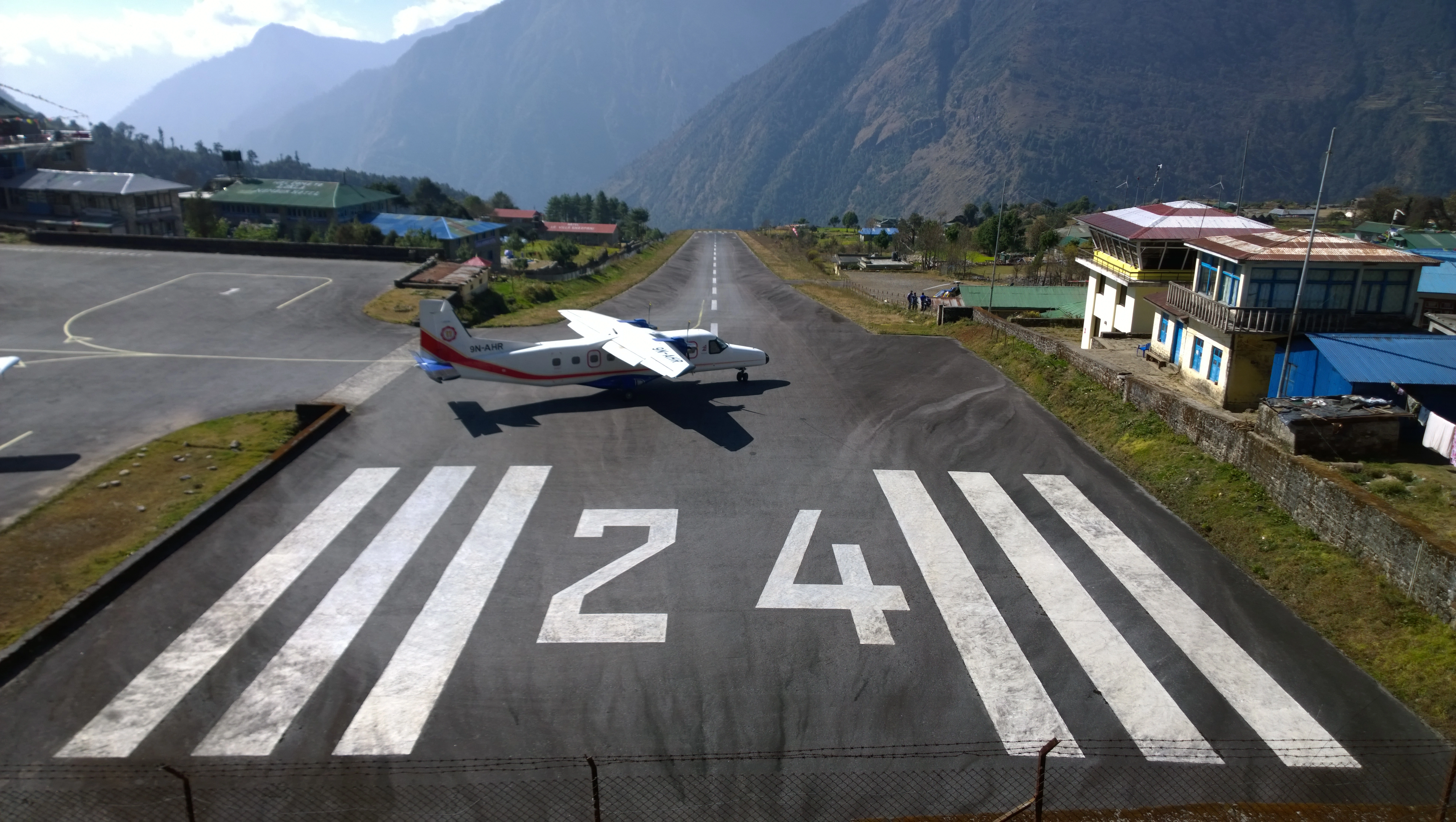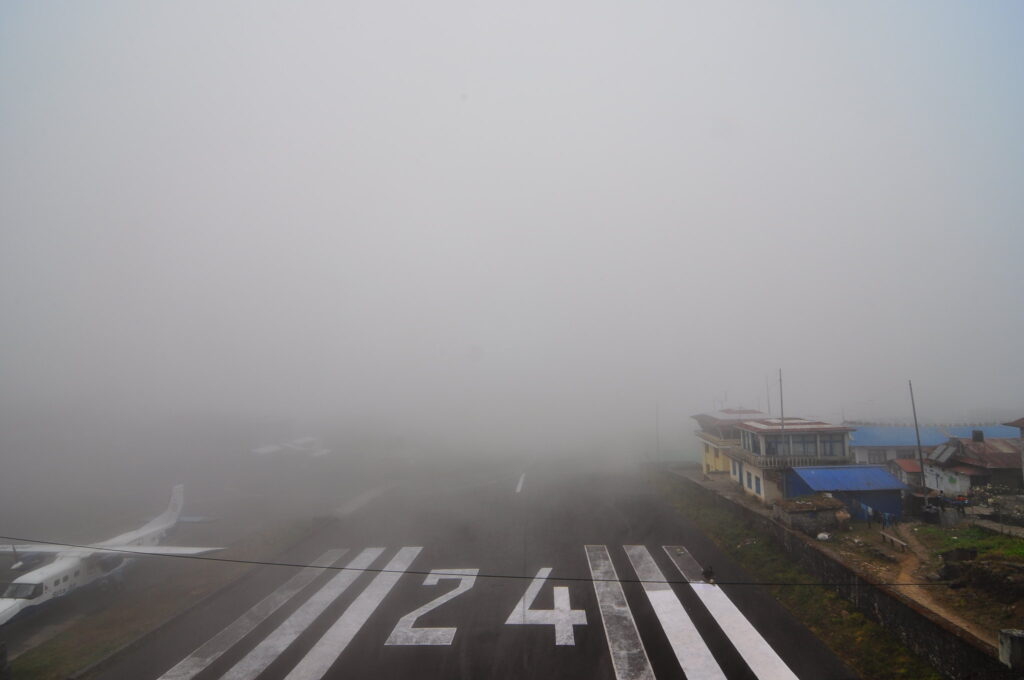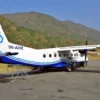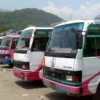Lukla Flight: A Complete Guide and Alternatives

The adventure to Everest Base Camp begins with an exhilarating flight to Lukla, a silent but lively mountain town that serves as the primary gateway for trekkers and climbers exploring the majestic Everest region. Known for its short, steep runway nestled between towering peaks, the flight to Lukla is often regarded as the first major thrill of the Everest journey. This high-stakes landing is not just about the adrenaline rush but also sets the tone for the excitement and challenges that lie ahead.
Lukla is a critical hub for mountain expeditions. As both the starting point for numerous treks and a vital acclimatization stop, it plays an important role in climbers’ preparations for the demanding trek to Everest Base Camp. Situated at an impressive altitude of 2,860 meters (9,383 feet) above sea level, Lukla offers trekkers the opportunity to adjust to high-altitude conditions, which is essential for minimizing the dangers of altitude sickness that can affect even seasoned adventurers.
In summary, a flight to Lukla is more than just a way to get to Everest Base Camp; it’s the exciting start of an epic adventure. The mix of adventure, preparation, and the lively community in Lukla sets the stage for an unforgettable journey into the Himalayas.
Overview of Lukla Airport (Tenzing-Hillary Airport)
Lukla Airport, also known as Tenzing-Hillary Airport, is famed for its challenging location and the skill required to land on its short, steep runway. At only 527 meters long, the runway ends abruptly at the edge of a cliff, offering no room for error. Named after Sir Edmund Hillary and Tenzing Norgay Sherpa, the first climbers to conquer Mount Everest, this airport holds historical significance and is a testament to the adventurous spirit of all who embark on this journey.
Despite its known as one of the most dangerous airports in the world, it facilitates tens of thousands of flights annually, safely transporting eager adventurers closer to the highest peaks on the planet.
Due to its extreme conditions, Lukla Airport and Lukla Flight has strict operational procedures to ensure the safety of both passengers and crew. Only specially trained pilots with specific experience in short takeoff and landing (STOL) aircraft are permitted to navigate this unique airstrip.
Flights to and from Lukla are heavily dependent on weather conditions, as visibility and wind can dramatically affect the safety of landings and takeoffs. It’s not uncommon for Lukla Flight to be delayed or canceled entirely due to poor weather.
The Lukla Flight Experience
Traveling to Lukla, Nepal, is more than just reaching a destination; it’s an adventure. From the moment you decide to go, you’re in for excitement and wonder.
With a short runway nestled between tall peaks and steep valleys, landing here gives a unique adrenaline rush. Pilots skillfully navigate through a mountain pass to land, setting the stage for an incredible journey.
Upon arrival, you’ll feel a mix of excitement and anticipation as you breathe in the crisp mountain air. Lukla buzzes with energy, with teahouses, shops, and cafes lining the narrow streets, ready to serve trekkers and climbers prepping for higher altitudes. You’ll encounter diverse travelers, from seasoned mountaineers to first-time adventurers, creating a sense of unity and shared purpose.
The real magic of Lukla lies in its surroundings. The Everest Region showcases stunning landscapes with snow-capped peaks, lush valleys, and picturesque villages. Treks from Lukla lead through beautiful rhododendron forests, across suspension bridges, and up steep paths offering panoramic views of some of the world’s highest mountains, including Mount Everest.
Pre-Flight Preparations to Lukla Flight
Preparing for a flight to Lukla requires thoroughness due to the unique challenges associated with traveling to one of the world’s most adventurous airports. Your preparation should include several crucial steps to ensure a safe, timely, and convenient journey to the Khumbu region.
Checklist: Essential Preparations Before Your Flight
Before heading to Lukla, here’s what you need to tick off:
- Travel Permits: Make sure that all the necessary permits for trekking in the stunning Everest Region are fully in order. This includes verifying that each required document is properly completed and submitted well ahead of your planned adventure. Having all the permits sorted out will ensure a smooth and enjoyable journey through the breathtaking landscapes of the park.
- Health Check-ups and Insurance: Make sure to schedule a comprehensive health check-up with your doctor to confirm you’re physically fit for the challenges of high-altitude environments. Discuss and receive any necessary vaccinations to protect yourself from regional health risks.
- Packing Essentials: Pack light but include warm clothing, waterproof jackets, comfortable trekking boots, a first-aid kit, and essential medication. Remember, the luggage limit for Lukla flights generally ranges from 10-15 kg.
- Local Currency: Withdraw enough Nepalese Rupees in Kathmandu, as ATMs are scarce and often unreliable in Lukla and the trekking areas.

Why Let Us Arrange Your Lukla Flight?
Planning a trip to Lukla? Here’s why you should use Namaste Nepal Trekking & Research Hub to handle your travel arrangements.
By booking through our dedicated travel service, you’ll enjoy numerous benefits, starting with personalized itinerary planning. Our team takes the time to understand your preferences and interests, crafting a travel plan that perfectly suits your needs. With our local insights, you’ll discover hidden gems and experience the authentic beauty of Lukla that most tourists miss.
Say goodbye to travel stress with our comprehensive accommodation and logistics management. We handle all the details, from securing comfortable accommodations to arranging safe transportation, so you can focus on soaking in the adventure without any worries.
And the support doesn’t stop there. Throughout your journey, our team is always available to assist you, ensuring you have a seamless and memorable experience. With Namaste Nepal Trekking & Research Hub Pvt. Ltd. by your side, your trip to Lukla will be more enjoyable and hassle-free than you ever imagined.
Cost of the Lukla Flights
| Sectors / Flight Route | Airline Company & Gross Fare | ||
| Tara Airlines | Sita Airlines | Summit Airlines | |
| Kathmandu – Lukla | $217 | $215 | $218 |
| Lukla – Kathmandu | $217 | $215 | $218 |
| Ramechhap – Lukla | $177 | $175 | $177 |
| Lukla – Ramechhap | $177 | $175 | $177 |
Weather Considerations and Best Time to Fly to Lukla
Understanding when to book your flight to Lukla can significantly impact your overall experience. Lukla’s weather is notoriously unpredictable, often changing rapidly within the same day. It is crucial to plan your travel during the best seasons to maximize your chances of smooth flights and clear skies.
Peak trekking seasons, particularly from late September to early December and mid-March to May, generally offer the most reliable weather conditions. During these times, you can expect a more stable climate, with clearer skies and less chance of rain or heavy cloud cover, which are important since flights to Lukla rely heavily on visual navigation.
Booking your flight during these peak seasons not only enhances your chances of timely departures and arrivals but also allows for a more enjoyable trekking experience, as the trails will be more navigable and the vistas more breathtaking. Remember to monitor weather forecasts closely as your travel date approaches, as unexpected weather patterns can still arise.
Best Time to Fly to Lukla
Flying to Lukla is best during the spring months of March to May and the autumn months of October to November. These periods offer the most stable weather conditions and high visibility, making them ideal for flights.
During these times, you can expect clearer skies and more predictable weather patterns, which are crucial for ensuring a smooth and safe flight. Additionally, the stable weather enhances your chances of witnessing the breathtaking scenery that the region has to offer. From the majestic peaks of the Himalayas to the lush greenery of the valleys, the clear skies will allow you to soak in every detail of the stunning landscape.
If you’re planning a trip to this remarkable destination, aiming for these seasons will not only make your travel experience more pleasant but also allow you to capture the extraordinary beauty of the area in all its glory.
Avoid Monsoon and Winter
It is advisable to avoid flying to Lukla during the monsoon season (June to September) and winter (December to February). During these periods, the weather can be quite unpredictable. The monsoon brings heavy rains, resulting in poor visibility and an increased risk of flight cancellations and delays. Similarly, winter months can bring harsh conditions, such as snow and strong winds, further complicating flight schedules and safety.
During the monsoon season, the region experiences heavy rains that significantly impair visibility. These conditions not only increase the likelihood of flight delays and cancellations but also pose potential risks to overall flight safety. The persistent rains can make it difficult for pilots to navigate and for flights to land or take off as scheduled.

The winter months bring their own set of challenges. From December to February, the area can be subjected to harsh weather conditions, including snowfall and strong winds. These elements can make flying particularly hazardous, complicating flight schedules and potentially leading to cancellations. Snow accumulations and icy runways make it even more difficult for flights to operate smoothly.
For these reasons, planning your trip outside of these months can greatly enhance your travel experience, ensuring more reliable and safer flights to Lukla. Find the detailed monthly breakdown of the weather at Lukla Airport:
Monthly Weather Breakdown of the Lukla Airport:
| Month | Temperature (°C) | Visibility Considerations |
| January | -5 to 5 | Generally clear skies, and good visibility. |
| February | -3 to 7 | Clear skies, and good visibility. |
| March | 5 to 15 | Clear skies, and good visibility. |
| April | 5 to 17 | Clear skies, and good visibility. |
| May | 10 to 20 | Clear skies, and good visibility. |
| June | 15 to 21 | Occasional clouds, visibility may vary. |
| July | 15 to 21 | Monsoon season, often cloudy, reduced visibility. |
| August | 15 to 21 | Monsoon season, cloudy, reduced visibility. |
| September | 10 to 19 | Monsoon season ends, improving visibility. |
| October | 5 to 15 | Clear skies, and good visibility. |
| November | 0 to 13 | Clear skies, and good visibility. |
| December | -3 to 5 | Clear skies, and good visibility. |
Visibility Considerations:
- Good Visibility: Generally 5 kilometers or more.
- Reduced Visibility: Below 5 kilometers, possibly due to fog, rain, or snow.
Direct Flight Option from Kathmandu to Lukla
Direct flights from Kathmandu to Lukla are a preferred choice for many due to their convenience. However, these flights are heavily dependent on weather conditions and can experience significant delays.
Flights from Kathmandu to Lukla usually take about 40 minutes. The cost can vary but generally falls within the range of USD 180 to USD 200 for foreigners. These flights are early in the morning to take advantage of the best weather conditions, which can dramatically change later in the day.
What to Expect
The flight from Kathmandu to Lukla is short, typically around 30-40 minutes, but it is packed with breathtaking views and an adrenaline rush. As the aircraft ascends from the Kathmandu valley into the clear blues of the sky, passengers are treated to a spectacular aerial view of Nepal’s rugged landscape, sprinkled with remote villages, terraced fields, and monasteries perched on hilltops.
Lukla Airport itself is situated at an altitude of 9,383 feet (2,860 meters) and features a uniquely short runway — just 527 meters long — with a 12% incline. Given its high altitude and the surrounding steep terrain, landing here is tricky. The approach to the runway comes with a sharp descend and requires precision and swift judgment, making this one of the most challenging landings globally.
Pros and Cons
Flying directly from Kathmandu offers the primary advantage of convenience. It eliminates the need for additional land travel and allows more time to acclimatize in Lukla before beginning treks. The direct route is highly sought after for these reasons.
However, these flights also have disadvantages, chiefly their dependency on weather. Lukla’s Tenzing-Hillary Airport is infamous for its challenging location and weather patterns, which frequently lead to flight delays and cancellations. Additionally, the congestion at Kathmandu’s airport can also lead to prolonged wait times and changes in flight schedules.
Reasons for Lukla Flight Cancellations
Anyone who has planned a trek to Everest Base Camp is no stranger to flight cancellations at Lukla’s Tenzing-Hillary Airport. This small airport, situated at an elevation of 2,845 meters (9,334 feet), is also known as the most dangerous airport in the world. With such a reputation, it’s fair to say that flights get delayed sometimes. In fact, flights to and from Lukla are canceled more often than you’d think. Below are some reasons why this happens so frequently:
Unpredictable Weather Conditions
Lukla flights often face delays or cancellations primarily because of unpredictable weather. Known for its stunning mountain scenery, Lukla also experiences rapidly changing and often erratic weather patterns. A day that begins with clear, blue skies can quickly transform into a scene of dense clouds, reducing visibility to almost zero. Flights to and from Lukla depend heavily on visual flight rules (VFR), which means pilots need a clear view to land and take off safely. No clear skies? No flight.
But it’s not just the flights that the weather affects. Trekkers and climbers face sudden changes, too. A sunny, calm hike can quickly turn into fierce winds, heavy rain, or snowfall. The trails can become slippery and risky, and temperatures may drop unexpectedly, catching even the most prepared off guard. Everyone must stay alert and ready for anything.
These unpredictable conditions can lead to delays. Imagine planning your trek for months, only to be stuck at the airport for days, waiting for clear weather. For locals, such delays disrupt essential supplies and make medical emergencies even more critical when flights are grounded. The constant uncertainty takes a toll on everyone.
Lukla, despite its stunning beauty, demands respect and readiness from all taking Lukla flight. The weather here is in charge, shaping experiences and daily life in this mountainous paradise.
Wind and Turbulence
Wind can be quite a troublemaker for flights, especially at Lukla Airport, known for being one of the world’s most dangerous. This small but vital airport sits at a high altitude of 9,334 feet (2,845 meters) and has a very short, steep runway, just 527 meters (1,729 feet) long.
Pilots must be extremely precise when landing on this narrow strip, where even small mistakes can lead to serious problems. Adding to the difficulty, wind conditions are often unpredictable, with sudden shifts that make safe landings and takeoffs even more challenging.
Pilots flying in and out of Lukla need to stay calm and make quick decisions. They often have to judge the wind’s timing and strength very quickly. A sudden gust can disrupt their approach or takeoff, making it safer to cancel the flight rather than risk an accident. As a result, flights to and from Lukla are often delayed or canceled due to bad wind conditions. Passenger safety always comes first, so when the winds become too strong, grounding the planes is the safest option.
Limited Operational Hours
Flights to and from Lukla are only available during daylight hours due to tough weather conditions, usually from early morning to around noon. Missing this time slot means waiting until the next day. Lukla’s high-altitude, short-runway airport is one of the world’s most challenging, and the weather is extremely unpredictable, often affecting flight schedules. Mornings offer the best weather, while afternoons bring clouds, fog, and strong winds, making flying unsafe.
Travelers heading to Everest Base Camp or returning from the Himalayas should be ready for delays and plan for extra days. The small flight window means delays or cancellations can quickly lead to backlogs, requiring patience and flexibility. Some opt for helicopter travel for more flexibility, though it’s more expensive.
In short, Lukla’s strict flight schedules and unpredictable weather make travel exciting. Being prepared for delays and keeping a flexible itinerary can make your journey smoother.
Aircraft Limitations
Most flights to Lukla are operated by small, fixed-wing aircraft, quite different from the large commercial jets you might be used to. These smaller planes are specifically designed to handle the short distances required for the journey to this remote mountainous region. However, the unique design and size of these aircraft come with certain limitations.
For one, they must strictly adhere to weight and balance constraints to ensure a safe flight. This can sometimes lead to delays, as the aircraft need to be precisely balanced before takeoff. Moreover, the number of planes available for such trips is quite limited, so if a flight is delayed or canceled, rescheduling can become a challenge.
You might find that there simply isn’t another aircraft available to make the journey on the same day, causing further delays. As such, flying to Lukla requires a bit of flexibility and patience, but the destination at the end is well worth the wait.
Lukla Flight Cancellations: Best Alternatives and Services
Alternatives to Flying into Lukla
Having your Lukla flight canceled is definitely frustrating, but it doesn’t necessarily mean the end for you adventure. You’ll be glad to know there are plenty of solid alternatives. Some of these options are equally scenic, if not more thrilling! Let’s dive into your options:
Alternative No.1: Helicopter Flight to Lukla/Kathmandu
Helicopters provide an exceptional level of flexibility, especially when dealing with challenging weather conditions that might otherwise disrupt travel plans. If flights are canceled due to adverse weather, many trekking agencies step in by arranging helicopter transport to alternative airstrips, such as Phaplu. Once at Phaplu, trekkers can continue their journey to Kathmandu with a scenic and comfortable jeep ride.
Helicopter flights have become a popular and often more reliable alternative to traditional fixed-wing aircraft. One of the main advantages is that helicopters can operate under less-than-ideal weather conditions and low visibility. This capability significantly increases the likelihood of safely reaching destinations like Lukla or Kathmandu, which are known for their challenging weather patterns.
Moreover, the journey itself is an unforgettable experience. Passengers can enjoy the amazing views of the Himalayas, providing a unique perspective on some of the world’s most stunning landscapes. The combination of reliability and scenic beauty makes helicopter flights an appealing option for travelers seeking both adventure and convenience.
Alternative No.2: Helicopter Flight to Surkhe/Kathmandu
If bad weather grounds your flight to Lukla, consider taking a helicopter to Surkhe, a nearby airstrip. The trek from Surkhe to Lukla takes 2-3 hours and combines air travel with a walk through the beautiful Khumbu region. Surkhe offers a less crowded route with stunning views and a chance to experience local culture.
You can gradually acclimate to the altitude, taking in the lush landscapes and serene surroundings that create a sense of peace and tranquility. As you travel the path to Lukla from Surkhe, you’ll notice it’s less commercialized compared to other routes. Along the way, you’ll encounter charming small villages, verdant terraced fields, and friendly locals who greet you with warm smiles and open hearts.
Choosing this option not only helps you avoid potential weather delays but also enriches your Everest trek with unique experiences. Instead of just another trekking route, it becomes an opportunity to immerse yourself in the local culture and natural beauty, making your journey to Everest truly memorable.
Alternative No.3: Drive to/from Tham Danda via Phaplu
Tham Danda is the closest location where you can drive to or from Lukla. If you’re planning a trip, you can hire a jeep from Kathmandu via Jiri, Shallari, and Phaplu and take a scenic drive all the way to Tham Danda. From there, it’s just a relatively easy hike to Lukla, making it an excellent alternative for travelers. This route is particularly favored during high trek seasons when flights are often subject to delays and disruptions. By choosing this option, you can avoid the uncertainty of air travel and enjoy the beautiful landscapes along the way. Perfect for adventurers seeking a more predictable and scenic journey to Lukla!
Pros:
- Beautiful landscapes: Enjoy stunning scenery with picture-perfect vistas, rolling hills, and charming countryside that you’d miss by plane or train.
- Control over your schedule: Be your own boss! Stop for picnics, photos, and set your own pace.
Explore lesser-known villages: Discover quaint, off-the-beaten-path villages with unique experiences, local cuisine, and authentic culture.
Cons:
- Longer travel time: Driving can take longer than flying or taking the train, which might be a concern if you’re on a tight schedule.
- Rough and bumpy drive: Some roads might have potholes and rough patches, so be prepared for a potentially bumpy ride.
Alternative No.4: Follow the Footsteps of World-Famous Mountaineers (Drive to/from Jiri)
Before Lukla Airport opened, trekkers heading to Everest Base Camp started their journey from Jiri. To add this classic touch to your own adventure, consider driving to Jiri and trekking to Lukla. This longer route offers rich cultural experiences and stunning scenery, with picturesque villages and terraced fields along the way. It also provides more time for acclimatization, making the trek to Everest Base Camp even more rewarding.
The Jiri to Lukla trek is also less crowded, giving you a more serene experience. You’ll cross high passes, deep gorges, and rhododendron forests, and enjoy the warm hospitality of the Sherpa people in remote villages. This route also allows you to visit lesser-known cultural sites and monasteries, adding peace and excitement to your journey.
Pros:
- Rich history and culture: Immerse yourself in fascinating stories and unique cultural practices of the region.
- Scenic views: Enjoy diverse landscapes, from lush valleys to rugged mountain paths.
- Traditional Sherpa life: Interact with the Sherpa community and experience their customs and hospitality.
Cons:
- Longer Trek (5-7 days): Be prepared for several days on the trail, which might be challenging if you’re short on time or not used to long hikes.
- Physical effort: The trek requires good physical fitness and possibly some training, as the varied and steep terrain demands both mental and physical resilience.
Fly to Lukla from Ramechhap Airport (Manthali Airport): A Key Alternative
During peak trekking seasons, flights are frequently rerouted to Manthali Airport in Ramechhap, which is approximately a 4-5 hour drive from Kathmandu. Though this adjustment adds an additional day to your journey, there’s a silver lining. Flights from Manthali to Lukla are generally more dependable and less chaotic compared to those that depart directly from Kathmandu. This can offer a smoother and more predictable travel experience, reducing the stress often associated with the bustling activity at Kathmandu Airport.
Ramechhap Airport serves as an increasingly popular alternative starting point for flights to Lukla, especially during the busy trekking seasons. Located around 130 kilometers east of Kathmandu, this airport plays a crucial role in easing congestion at Kathmandu’s Tribhuvan International Airport. Particularly during peak periods, many trekkers now fly from Ramechhap to Lukla.
Ramechhap Airport, also known as Manthali Airport, is becoming a key hub for flights to Lukla, especially since it reduces the pressure on Kathmandu’s main airport. This shift has been implemented largely during the spring and autumn trekking seasons when air traffic peaks due to favorable weather conditions. The airport’s increasing use helps in managing the flow of tourists heading to the Everest region more efficiently.
Why they operate Flights to Lukla From Ramechhap (Manthali Airport)
Flying to Lukla, the gateway to Everest, is quite an adventure! You’ll be flying over the Himalayas with stunning views and lots of excitement as you approach this famous airport. But keep in mind, flights often get canceled due to unpredictable weather to ensure everyone’s safety. High winds, dense fog, and swift changes in weather make flying here tricky.
Recently, there’s been a change in the schedule. Flights to Lukla now depart from Ramechhap (Manthali) Airport instead of Tribhuvan International Airport in Kathmandu. This change helps reduce air traffic and should improve your overall experience. It adds an extra step to your journey, but it’s all part of the adventure in this amazing region. So, bring your patience and get ready for an unforgettable trip from the moment you take off!
This change helps manage heavy air traffic at Kathmandu’s airport, especially during peak trekking seasons. Ramechhap, about 132 kilometers (4-5 hours by road) from Kathmandu, helps minimize delays. Less air traffic at Ramechhap means flights can stick to their schedules, which is great for eager trekkers.
Lukla’s Tenzing-Hillary Airport, surrounded by high peaks and tricky weather, is prone to delays and cancellations. With fewer crowds at Ramechhap, airlines can better manage schedules, and pilots can optimize travel times when the weather is good. The goal of moving operations is to ensure travelers can start their Everest trek with minimal hassle. While it might add an extra leg to your journey, the benefits of safety, fewer delays, and better travel efficiency make it worth it
Why Should You Fly From Ramachap to Lukla?
Flying from Ramachap to Lukla has become a preferred route for many trekkers heading towards the Everest region.
By starting your journey from the Manthali Airport in Ramachap, you can avoid the crowding of Kathmandu’s Tribhuvan International Airport and ensure a smoother, more relaxed beginning to your trek.
Additionally, There are a couple of key reasons why this option stands out:
Weather and Flight Safety:
Lukla is one of the world’s toughest airports due to bad weather, especially in the mornings, making flights difficult and often delayed. However, using Ramachap airport instead can help avoid these issues seen with flights from Kathmandu. This alternative route offers a safer and more reliable journey, cutting down on weather-related delays and improving the travel experience.
Reducing crowds:
Kathmandu’s Tribhuvan International Airport is always busy with many flights coming and going, both from within Nepal and around the world. It’s a key travel spot, often crowded. To help with this, a new plan will move Lukla flights to Ramachap. This will ease the congestion at the airport, making it less crowded and more comfortable for everyone. The change will also make traveling smoother and less stressful. So, next time you pass through, you might notice a bit more space and a lot less hassle.
- More Reliable Schedules:
With Ramachap being dedicated primarily to Lukla flights, there is generally a more reliable flight schedule. The probability of delays decreases, which means trekkers can stick to their plan and not lose precious days waiting. Flying through Ramachap makes it easier for Everest Base Camp trekkers by reducing air travel hassles. With fewer cancellations and rescheduling, trekkers can better manage their time and stays, leading to a more relaxed and enjoyable adventure. This efficiency lets them focus more on the stunning landscapes and the exciting trek ahead.
- Scenic Route:
The flight from Ramachap to Lukla offers a breathtaking aerial perspective of the Himalayas. While safety and efficiency are the primary reasons for this route, the added bonus is the stunning views that passengers can enjoy as they fly towards their trekking adventure. As the plane approaches Lukla, excitement builds. Lukla Airport’s steep hillside location makes for an thrilling landing. Once you touch down, the adventure begins. Trekking trails take you through green forests, waterfalls, and over suspension bridges above rushing rivers. You’ll see snowy mountain tops, deep valleys, glacial lakes, and small villages.
- Cost-Effective and Time Efficiency:
This route not only saves you valuable time but also proves to be more cost-effective. Flying from Ramachap to Lukla generally offers more competitive prices compared to flights from Kathmandu. Plus, the time saved from fewer delays and a smoother journey means you can spend more time exploring the wonders of the Everest region rather than waiting around at airports.
In summary, Flying from Ramachap to Lukla offers better safety, fewer crowds, reliable schedules, stunning views, and cost-effective travel. It’s a great way to begin an unforgettable adventure in the Everest region, where every moment matters. if you wish to know more about the Ramechhap to Lukla flight worth Reading:
How to get to Ramechhap Airport from Kathmandu
Reaching Ramechhap from Kathmandu typically involves a road journey of approximately 4-5 hours. Transport options include local buses, private vehicles, or organized transfers by trekking companies. The road trip, while adding extra travel time compared to flying directly from Kathmandu, can be a scenic and enriching experience, offering a glimpse of Nepal’s countryside. Read more at:
Lukla Flights Operational Details
Operational details are as crucial as the flight journey itself, especially when it involves one of the world’s most dangerous airports. Located at an altitude of 9,334 feet in the Himalayan mountains, the Lukla Airport is renowned for its short runway and challenging weather conditions.
Typically, flights to Lukla are scheduled early in the morning, as this is when the weather is likely to be clear and more stable. This small window of favorable weather is critical because conditions can change rapidly, making it difficult for planes to safely land or take off later in the day.
The major airlines that facilitate this route include Tara Air and Sita Air. These airlines operate relatively small aircraft, such as the DHC-6 Twin Otter and Dornier 228, which are specifically adapted for short takeoff and landing. These planes are capable of navigating the rugged terrain and unique challenges posed by Lukla Airport, ensuring that passengers can embark and disembark as safely as possible.
Flights are highly dependent on weather conditions, so schedules can be subject to delays and changes without much notice. Pilots need to have clear visibility and calm winds to safely operate in and out of Lukla, leading to frequent adjustments based on real-time weather reports.
During the peak trekking seasons in spring (March to May) and fall (October to November), the frequency of flights increases significantly. This is to accommodate the high number of trekkers heading to Everest Base Camp and other high-altitude treks. During these times, airlines may add additional flights to meet the demand, but it’s still advisable for travelers to remain flexible with their itineraries due to the unpredictable weather.
Is the Flight to Lukla Airport Safe?
Yes, the flight to Lukla Airport, although famous for its thrilling and adventurous nature, is generally considered safe. Lukla’s Tenzing-Hillary Airport sits at 2,860 meters and is surrounded by mountains, posing unique challenges. However, experienced pilots trained for this high-altitude airport handle these flights.
The short runway and its location require precision and skill. Airlines follow strict safety protocols and use suitable aircraft. Safety measures include rigorous pilot training and adherence to strict standards. Pilots have vast experience with short takeoff and landing (STOL) operations and know the local weather and terrain.
Flights only operate in favorable weather to ensure safety. Although Lukla is often called one of the most dangerous airports due to its location and technical demands, the flight record shows it is a secure mode of transportation with the right precautions. While incidents have occurred, they are rare compared to the number of flights.
How To Overcome Weather Changes and Delays
Traveling to and from Lukla can sometimes be unpredictable, primarily due to the weather conditions in the mountainous region. Understanding common reasons for these changes and having tips for managing delays can help make your trip smoother.
Common Reasons for Delays and Cancellations
Flights to and from Lukla are highly susceptible to weather changes. Common reasons for flight cancellations or delays include:
- Foggy conditions that reduce visibility below the minimum required for safe landing and takeoff.
- Strong winds can make flying hazardous, particularly given the short runway and the surrounding mountains.
- Heavy Rainfall, including rain and snow, which can obscure visibility.
- Cloud cover that settles in the mountain valleys.
Apart from weather conditions, operational issues such as technical problems with an aircraft can also lead to delays. However, airlines serving Lukla are generally well-prepared with backup plans and maintain high standards of maintenance to minimize such occurrences.
Tips for Handling Sudden Weather Changes
Here are some guidelines to help handle changes in your flight itinerary when traveling to or from Lukla:
- Plan Extra Days: Always include one or two buffer days in your travel itinerary. This can be crucial if you need to catch an international flight after your trek or if you have other scheduled activities. Stay Informed: Keep in regular contact with your airline or tour operator regarding weather conditions and flight status.
- Early Flights: Always opt for the earliest flights to Lukla. Weather conditions tend to be more stable in the morning, which can lower the chance of delays.
- Local Accommodations: Have a contingency plan for accommodations in Lukla or the town from which you are flying (Kathmandu or Ramechhap) in case of an unexpected overnight delay.
- Travel Insurance: Make sure your travel insurance covers trip cancellations and interruptions due to weather and other unforeseen delays.
- Stay Flexible: Be mentally prepared for last-minute changes and maintain a flexible attitude towards travel planning.
By understanding these common concerns and how to address them, travelers can reduce stress and manage their schedules more effectively during their adventure to or from Lukla. If you wish to see the Lukla Airport Live Weather Update now Click Here
FAQs About Lukla Flight
1. What is a Lukla flight?
A Lukla flight takes passengers from Kathmandu to Lukla, the main entry point for trekkers going to Everest Base Camp. This short but thrilling trip offers breathtaking views of the Himalayas and sets the stage for an unforgettable adventure in the Everest region.
2. Why is Lukla Airport considered dangerous?
Lukla Airport, officially named Tenzing-Hillary Airport in honor of the famous mountaineers Tenzing Norgay and Sir Edmund Hillary, is renowned for its challenging conditions and is considered one of the most dangerous airports in the world. The airport is located in the Himalayas at an elevation of about 2,845 meters (9,334 feet), and its runway is remarkably short, measuring just around 527 meters (1,729 feet) in length.
3. How do I prepare for a flight to Lukla?
Essential preparations include obtaining travel permits, having health check-ups, packing appropriately with warm clothing and essential medications, and carrying enough local currency as ATMs in Lukla are scarce.
4. When is the best time to fly to Lukla?
The best times to fly to Lukla are during the spring (March to May) and autumn (October to November) seasons, offering stable weather and clear skies conducive for safe flight operations.
5. Are flights to Lukla often delayed or canceled?
Yes, flights to Lukla are only sometimes delayed or canceled due to unpredictable weather conditions like fog, strong winds, and heavy rain or snow, affecting visibility and safety.
6. Do I need travel permits to trek to Everest Base Camp?
Absolutely, you’ll need several permits to trek in the Everest region. Make sure to complete and submit all the required documents before your journey to avoid any disruptions.
7. Can I fly to Lukla from an alternative airport?
Yes, Ramechhap Airport is a popular alternative, especially during peak trekking seasons. It helps reduce congestion at Kathmandu’s main airport.
8. Are helicopter rides to Lukla a feasible option?
Helicopter rides are a flexible and often safer alternative to fixed-wing flights, handling adverse weather better. They can also land in nearby areas like Surkhe or Phaplu if weather disrupts direct flights.
9. What are the operational details for Lukla flights?
Lukla flights are typically scheduled in the early morning, using small aircraft suitable for short runways. Major airlines like Tara Air and Sita Air operate these flights, focusing on safety and weather conditions.
10. Is the Lukla flight safe?
Yes, while the Lukla flight is adventurous, it’s generally safe due to strict safety protocols, experienced pilots, and the use of suitable aircraft. Flights only operate under favorable weather conditions.
11. How can I handle delays and cancellations due to weather?
To manage potential delays, include buffer days in your itinerary, opt for early flights, stay informed about weather updates, have contingency accommodation plans, and ensure travel insurance covers interruptions.
12. What are trekking options to reach Lukla instead of flying?
For those with extra time, trekking from Salleri offers a scenic alternative. It includes a 4-5 day trek through lush forests and Sherpa villages, providing a richer experience of Nepal’s landscape and culture.







